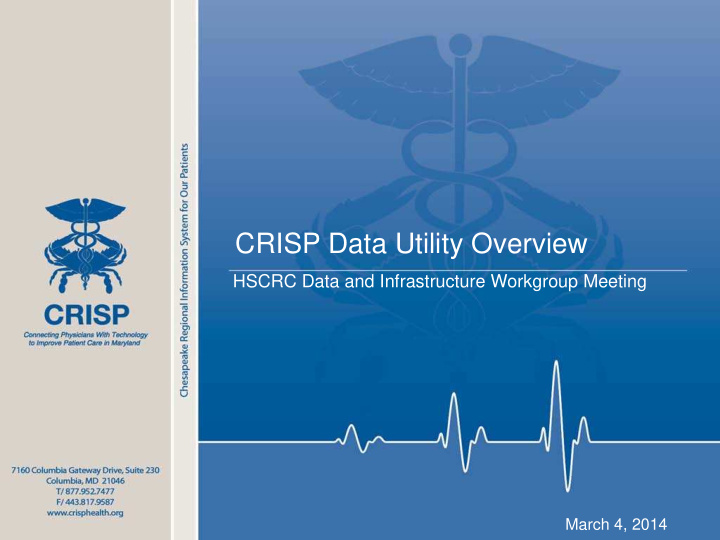



CRISP Data Utility Overview HSCRC Data and Infrastructure Workgroup Meeting March 4, 2014
CRISP Services Overview 2
Patient Identity Management The Challenge: Accurately and consistently linking identities across multiple facilities to create a single view of a patient. A near-zero tolerance of a false positive match rate with a low tolerance of a false negative match rate. Effective Master Patient Indexing is a foundational concept to any population health-oriented or cross- entity payment or delivery reform initiatives. 3
Reporting Background CRISP receives real-time encounter messages (called “ADTs”) which carry facility, medical record number, visit IDs, and other important information about visit. Unique Aspects of ADTs: Enable population-health analysis (unduplicated users across hospitals) Real –Time data flows Street address, enabling more granular level of geographic analysis Linked ADT and HSCRC Abstract Data enables cross-entity and geographically granular analysis 4 4
CRS Basic Design 5 5
Reporting Capability - Sample Reports CRISP has developed the capability to generate reports through a combination of CRISP data and HSCRC tape data. Initial report ideas include: Readmission analysis reports Market share analysis Clinical service line utilization by hospital Monthly reports with patient drill downs Year-to-year and monthly PSA By hospital, zip, region, county, HEZ by majority of inpatient visits, total visits, etc. by diagnosis or disposition by diagnosis and charges Patient attribution analysis Analysis of Potentially Avoidable Volume based on prior visits Visits with ambulatory sensitive conditions identify exclusive patients and % of visit Readmission Market share shifts allocation by patient by census tract or neighborhood by diagnosis and charges Episode of Care analysis all subsequent hospital visits after discharge by diagnosis or disposition High utilization analysis by # of visits, LOS, date, overlap, etc. by census tract or neighborhood by census tract or neighborhood by diagnosis, disposition, or charges Uncompensated Care/ACA Impact Using CRISP EID to link insurance status Hospital Utilization by diagnosis, disposition, and UCC use across time periods charges using HSCRC data County reports (patients, discharges, readmits by diagnosis) 6 6
Upcoming Changes to our Readmission Report Historically, our readmissions reports have relied on “basic” inter-hospital readmission logic using ADT data. This allowed hospitals an early view of inter-hospital readmissions. We are currently aligning our logic to exactly match the logic HSCRC will use to measure readmissions, including: • Using tape data visits (vs. real time ADTs) • Using same exclusions as HSCRC. CRISP will offer several reports of Intra-Hospital and Inter-Hospital readmissions to help track performance: • Monthly trend w/Medicare FFS • Statewide comparisons by clinical service line 7 7 • Monthly MRN drill down (shown here)
Utilization by Census Tract Map 8 8
County HD Dashboard Top IP Diagnoses 9 9
County HD Dashboard IP High Utilizers 10 10
County HD Dashboard IP Readmission Maps 11 11
Recommend
More recommend